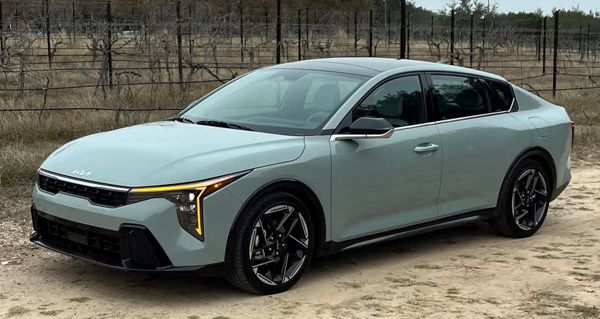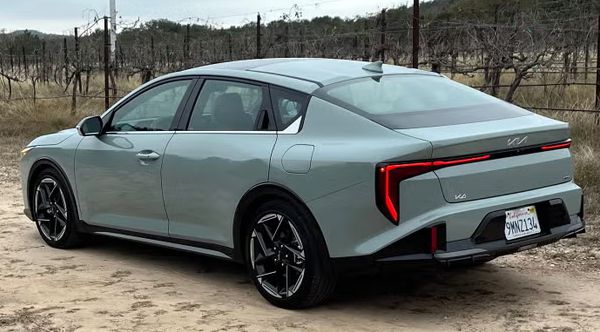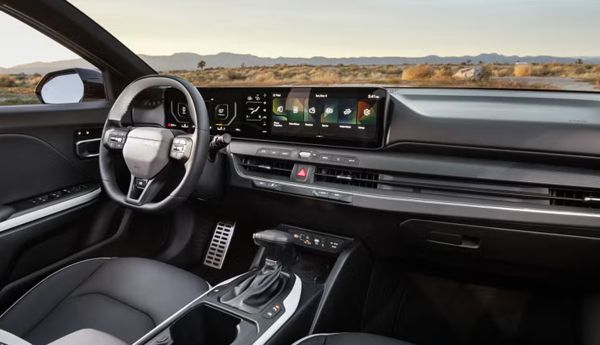Published
on 23
Jan 2025
|
All rights reserved.
|
|
|

|
|
The
K4 is high on style, at least that’s what its designers think.
|
|
Having been marketing as
Cerato in Korea or Forte in
North America for many years, Kia renames its compact family sedan to
K4, aligning with its other sedans K5, K8 and K9. Strangely, the new
car is not offered at its home market, as Kia focuses on its new EVs
and RVs for private buyers. At the moment, the K4 is built exclusively
in Mexico to supply the USA and Canada, although it is also exported to
Australia. However, later this year it will be offered in Europe as
well under the name Ceed. That will be built in Slovakia and include a
hatchback body option.
Calling it a “compact car” is debatable, because at 4.7 meters long,
1.85 meter wide and sporting a 2720 mm wheelbase it challenges the
boundary of compact or C-segment cars. In fact, it is just as big as
the last generation Volkswagen Passat, so you might call it a D-segment
car as well. However, in terms of pricing and market positioning, the
K4 definitely keeps getting buyers from the compact car segment. In the
US market, it starts at just $22,000 and tops out at $28,000, the same
money as what Honda charges for Civic or Toyota for Corolla.

|
|
At
4.7m long, 1.85m wide and 2720mm in wheelbase, it is just as big as the
last generation VW Passat.
|
|
The K4 is high on style, at least that’s what its designers think. It
is still a 4-door sedan but it is shaped to be as sleek as a fastback.
I like the tasteful “tiger nose” grille, but the tri-star headlamps are
too heavy-handed, as are the trapezoidal brake ducts. At the back, the
triangular C-pillars are reminiscent of the game-changing Stinger GT,
but the designers put too many elements into the crowded space around
its rear quarter windows, including a chromed kick at the lower corner
of those windows and the pillar-mounted door handles. The intersection
between roof and C-pillar looks odd and unrefined. The black window
frames look too thick and plasticky – a flaw shared with its sister car
Hyundai Elantra. It would be good if Kia spent more time refining the
design.
As the car grows 70mm longer, 50mm wider and 20mm in wheelbase, Kia
claims the best-in-class space for rear passengers. Undeniably, the
K4’s rear bench is spacious. Not sure if it is more so than Honda
Civic, but it is definitely one of the roomiest in its class, offering
abundant legroom and headroom. The boot is also very generous.
The dashboard design has little to write about. It features a flat
panel which houses up to 12.3-inch digital instrument and a touchscreen
of the same size simultaneously. The infotainment system is easy to use
enough, while some physical switches are retained for easier access to
climate control and audio. Materials used are typically hard and
unsophisticated for a budget car.

|
|
Roomy and
generally comfortable, but lacks driver appeal and a hybrid option.
|
|
The underpinnings are shared with Hyundai Elantra, and you will find
many key elements are actually carried over from the last generation,
most notably the base model’s 2.0-liter Atkinson-cycle engine with 147
hp and CVT combo. As the larger car gets a little heavier, it
gets slightly slower. GT-line Turbo also retains the old car’s
1.6-liter direct injection turbo unit, but it is detuned from 201 to
190 horsepower for improved fuel economy, and the outgoing DCT has been
replaced with an 8-speed automatic. It is also slower than before, but
the smoother power delivery suits the car, which is no driver’s car
admittedly.
The chassis is adapted from the last generation as well. Cooking models
use a simple torsion-beam rear axle, while turbo engine mandates the
upgrade to multi-link system. Ride comfort and refinement sees
noticeable improvement, although GT-line’s wide and low profile tires
do transmit more impacts into the cabin. At least the multi-link
suspension keep the car stable and well-controlled in corners. It does
most things well but never excites you, because the steering refuses
to communicate and the Kumho tires give up roadholding quickly. The
turbo engine
also discourages a spirited drive by running out of steam early in its
narrow rev range.
As a sensible family car, the K4 also suffers from lacking a hybrid
option. Toyota and Honda sell a lot of their Corolla and Civic with
hybrid power, but Hyundai group decides to direct its resources to
full-electric, so the K4 is found in an embarrassing position. It has
to rely on existing hardware to serve the shrinking demand for
conventional ICE family cars. It would be interesting to see if the
European Ceed will add plug-in hybrid options, but in North America the
K4 is destined to decline in market share.
|
Verdict:    |
|